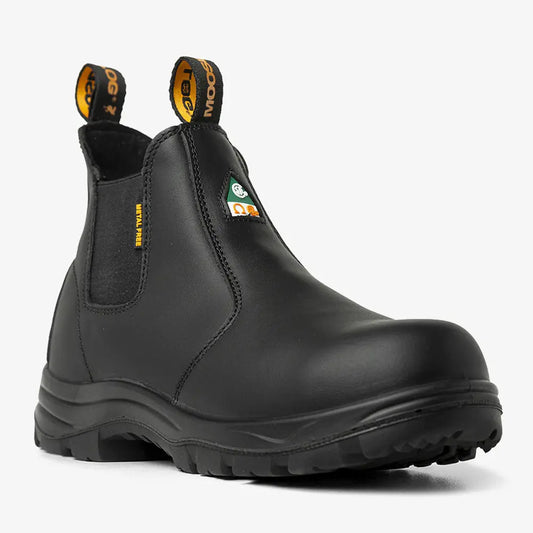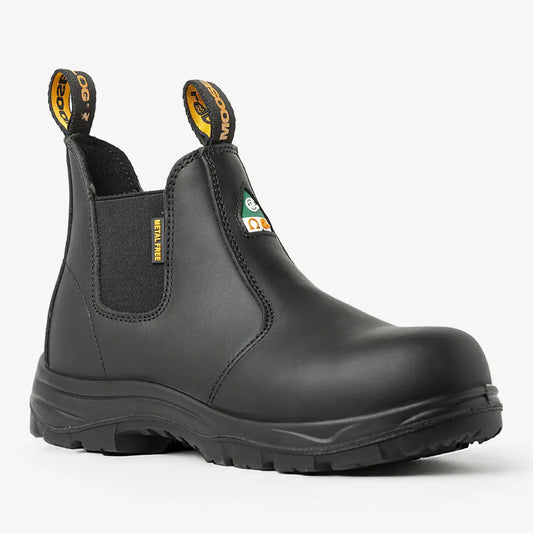
How to Choose the Right Work Boots for Standing All Day
If you’ve ever worked a full shift on your feet, you know the toll it takes. Long hours standing on concrete or uneven surfaces can leave you exhausted, sore, and distracted. The right pair of work boots provides safety while keeping you comfortable, stable, and focused throughout the day.
In this guide, you’ll learn what to look for in work boots designed for standing all day, how certification impacts safety and performance, and why the right choice can make the difference between fatigue and confidence at work.
Why Standing All Day is Hard on the Body
When you stand in one spot or move constantly without proper support, your body absorbs impact in ways it wasn’t designed to. Some of the most common issues include:
- Foot pain and swelling: Continuous pressure leads to soreness.
- Joint and back strain: Hard floors and poor cushioning stress knees, hips, and lower back.
- Plantar fasciitis: A common injury from insufficient arch support.
- Reduced focus: Fatigue causes discomfort and raises the risk of accidents.
According to a 2025 study published in the International Journal of Environmental Research and Public Health, workers who stand continuously for more than 6 hours have about 2× the odds of developing musculoskeletal disorders compared to those who don’t. This is why choosing the right work boot is essential, not optional.

Key Features of Work Boots for Standing All Day
When you’re buying boots, comfort features matter just as much as safety certifications. Here’s what to prioritize:
1. Lightweight Safety Toe
Traditional steel toes protect, but they’re heavy. Composite toes, like those in MooseLog boots, are lighter and metal-free while still meeting CSA and ASTM standards.
2. Shock-Absorbing Insoles
Look for insoles that rebound with every step, reducing impact on joints. High-rebound PU insoles are ideal for long shifts.
3. Slip-Resistant Outsoles
A solid grip keeps you safe on wet, oily, or dusty surfaces. SafeTread™ outsoles, for example, are designed for maximum traction.
4. Proper Arch and Heel Support
Without ergonomic support, weight distribution is uneven, leading to fatigue and injury.
5. Breathability and Fit
Sweaty feet lead to blisters and discomfort. Boots with breathable lining and a proper fit reduce friction and keep you moving.
Related Blog: Inside a Safety Boot: Every Layer Explained
Safety Certifications: Why They Still Matter
Comfort is crucial, but if your boots aren’t certified, you may not be protected or even allowed on the jobsite.
- CSA Z195 (Canada): Covers toe protection, sole puncture resistance, slip resistance, and electrical hazard ratings.
- ASTM F2413 (U.S.): Similar coverage, with different testing requirements.
If you work in Canada, you’ll need CSA. In the U.S., ASTM is the standard. If you cross between markets, dual-certified boots (like MooseLog’s) make sure you’re covered everywhere.
Composite Toe vs. Steel Toe for Long Shifts
Both have advantages:
- Steel Toe: Extremely strong, often heavier.
- Composite Toe: Lighter, doesn’t conduct heat or cold, and is airport-friendly.
For standing all day, most workers prefer composite because reduced weight means reduced fatigue. There’s also a third option, alloy toe boots, which use lightweight metals like aluminum or titanium for protection while staying thinner than steel. If you’d like a full comparison of steel, composite, and alloy toes, see our in-depth guide on toe protection.
Industry-Specific Considerations
Different jobs demand different features:
- Warehousing & Logistics: Cushioning and slip resistance matter most.
- Construction & Trades: Puncture resistance and toe protection are critical.
- Utilities & Manufacturing: Electrical hazard (EH) rated boots add essential protection.

MooseLog’s Approach to All-Day Comfort
At MooseLog, we know Canadian workers spend long hours on their feet. That’s why every pair of MooseLog boots combines CSA and ASTM certification with features that make standing all day less punishing:
- Composite toe for lightweight protection.
- PU high-rebound insoles for shock absorption.
- SafeTread™ slip-resistant outsole for all-surface stability.
- Built rugged for construction, warehouses, and utilities.
Shop MooseLog CSA & ASTM Certified Work Boots
Expert Insight
Research from the Canadian Centre for Occupational Health and Safety shows that prolonged standing is linked to sore feet, leg swelling, muscle fatigue, and lower-back pain. Studies also confirm that footwear with proper support and lighter weight materials can reduce discomfort and lower the risk of injury during long shifts
FAQ: Standing All Day in Work Boots
1. Are composite toe boots good for standing all day?
Yes. They’re lighter than steel, reducing fatigue.
2. What insoles are best for long shifts?
High-rebound polyurethane or memory foam insoles offer shock absorption.
3. Do CSA certified boots provide comfort?
Certification ensures safety, but comfort depends on design. Look for both.
4. How can I reduce fatigue while standing all day?
Wear certified boots with proper support, use anti-fatigue mats when possible, and stretch regularly.
5. How long should work boots last if worn daily?
On average, 12–18 months, depending on jobsite conditions and usage.
Conclusion
Standing for long hours will always be demanding, but the right boots decide whether you finish your shift in pain or with energy left. Lightweight composite toes, shock-absorbing insoles, and certified slip-resistant outsoles are the difference between fatigue and confidence. Choosing CSA or ASTM approved footwear built for all-day wear ensures your safety requirements are met while keeping your body supported where it matters most.






